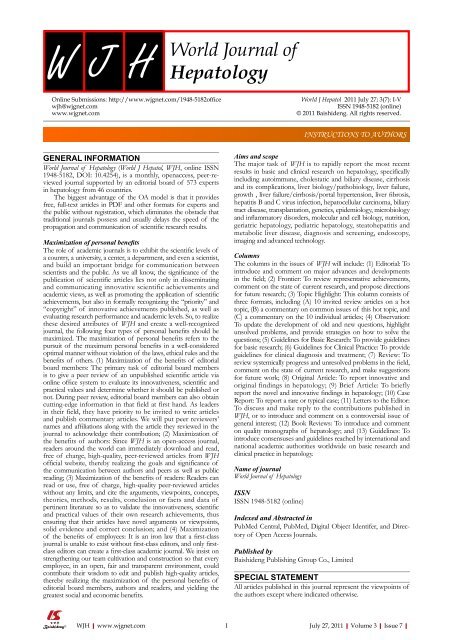7 - World Journal of Gastroenterology
7 - World Journal of Gastroenterology
7 - World Journal of Gastroenterology
- No tags were found...
Create successful ePaper yourself
Turn your PDF publications into a flip-book with our unique Google optimized e-Paper software.
Online Submissions: http://www.wjgnet.com/1948-5182<strong>of</strong>ficewjh@wjgnet.comwww.wjgnet.com<strong>World</strong> J Hepatol 2011 July 27; 3(7): I-VISSN 1948-5182 (online)© 2011 Baishideng. All rights reserved.INSTRUCTIONS TO AUTHORSGENERAL INFORMATION<strong>World</strong> <strong>Journal</strong> <strong>of</strong> Hepatology (<strong>World</strong> J Hepatol, WJH, online ISSN1948-5182, DOI: 10.4254), is a monthly, openaccess, peer-reviewedjournal supported by an editorial board <strong>of</strong> 573 expertsin hepatology from 46 countries.The biggest advantage <strong>of</strong> the OA model is that it providesfree, full-text articles in PDF and other formats for experts andthe public without registration, which eliminates the obstacle thattraditional journals possess and usually delays the speed <strong>of</strong> thepropagation and communication <strong>of</strong> scientific research results.Maximization <strong>of</strong> personal benefitsThe role <strong>of</strong> academic journals is to exhibit the scientific levels <strong>of</strong>a country, a university, a center, a department, and even a scientist,and build an important bridge for communication betweenscientists and the public. As we all know, the significance <strong>of</strong> thepublication <strong>of</strong> scientific articles lies not only in disseminatingand communicating innovative scientific achievements andacademic views, as well as promoting the application <strong>of</strong> scientificachievements, but also in formally recognizing the “priority” and“copyright” <strong>of</strong> innovative achievements published, as well asevaluating research performance and academic levels. So, to realizethese desired attributes <strong>of</strong> WJH and create a well-recognizedjournal, the following four types <strong>of</strong> personal benefits should bemaximized. The maximization <strong>of</strong> personal benefits refers to thepursuit <strong>of</strong> the maximum personal benefits in a well-consideredoptimal manner without violation <strong>of</strong> the laws, ethical rules and thebenefits <strong>of</strong> others. (1) Maximization <strong>of</strong> the benefits <strong>of</strong> editorialboard members: The primary task <strong>of</strong> editorial board membersis to give a peer review <strong>of</strong> an unpublished scientific article viaonline <strong>of</strong>fice system to evaluate its innovativeness, scientific andpractical values and determine whether it should be published ornot. During peer review, editorial board members can also obtaincutting-edge information in that field at first hand. As leadersin their field, they have priority to be invited to write articlesand publish commentary articles. We will put peer reviewers’names and affiliations along with the article they reviewed in thejournal to acknowledge their contribution; (2) Maximization <strong>of</strong>the benefits <strong>of</strong> authors: Since WJH is an open-access journal,readers around the world can immediately download and read,free <strong>of</strong> charge, high-quality, peer-reviewed articles from WJH<strong>of</strong>ficial website, thereby realizing the goals and significance <strong>of</strong>the communication between authors and peers as well as publicreading; (3) Maximization <strong>of</strong> the benefits <strong>of</strong> readers: Readers canread or use, free <strong>of</strong> charge, high-quality peer-reviewed articleswithout any limits, and cite the arguments, viewpoints, concepts,theories, methods, results, conclusion or facts and data <strong>of</strong>pertinent literature so as to validate the innovativeness, scientificand practical values <strong>of</strong> their own research achievements, thusensuring that their articles have novel arguments or viewpoints,solid evidence and correct conclusion; and (4) Maximization<strong>of</strong> the benefits <strong>of</strong> employees: It is an iron law that a first-classjournal is unable to exist without first-class editors, and only firstclasseditors can create a first-class academic journal. We insist onstrengthening our team cultivation and construction so that everyemployee, in an open, fair and transparent environment, couldcontribute their wisdom to edit and publish high-quality articles,thereby realizing the maximization <strong>of</strong> the personal benefits <strong>of</strong>editorial board members, authors and readers, and yielding thegreatest social and economic benefits.Aims and scopeThe major task <strong>of</strong> WJH is to rapidly report the most recentresults in basic and clinical research on hepatology, specificallyincluding autoimmune, cholestatic and biliary disease, cirrhosisand its complications, liver biology/pathobiology, liver failure,growth , liver failure/cirrhosis/portal hypertension, liver fibrosis,hepatitis B and C virus infection, hepatocellular carcinoma, biliarytract disease, transplantation, genetics, epidemiology, microbiologyand inflammatory disorders, molecular and cell biology, nutrition,geriatric hepatology, pediatric hepatology, steatohepatitis andmetabolic liver disease, diagnosis and screening, endoscopy,imaging and advanced technology.ColumnsThe columns in the issues <strong>of</strong> WJH will include: (1) Editorial: Tointroduce and comment on major advances and developmentsin the field; (2) Frontier: To review representative achievements,comment on the state <strong>of</strong> current research, and propose directionsfor future research; (3) Topic Highlight: This column consists <strong>of</strong>three formats, including (A) 10 invited review articles on a hottopic, (B) a commentary on common issues <strong>of</strong> this hot topic, and(C) a commentary on the 10 individual articles; (4) Observation:To update the development <strong>of</strong> old and new questions, highlightunsolved problems, and provide strategies on how to solve thequestions; (5) Guidelines for Basic Research: To provide guidelinesfor basic research; (6) Guidelines for Clinical Practice: To provideguidelines for clinical diagnosis and treatment; (7) Review: Toreview systemically progress and unresolved problems in the field,comment on the state <strong>of</strong> current research, and make suggestionsfor future work; (8) Original Article: To report innovative andoriginal findings in hepatology; (9) Brief Article: To brieflyreport the novel and innovative findings in hepatology; (10) CaseReport: To report a rare or typical case; (11) Letters to the Editor:To discuss and make reply to the contributions published inWJH, or to introduce and comment on a controversial issue <strong>of</strong>general interest; (12) Book Reviews: To introduce and commenton quality monographs <strong>of</strong> hepatology; and (13) Guidelines: Tointroduce consensuses and guidelines reached by international andnational academic authorities worldwide on basic research andclinical practice in hepatology.Name <strong>of</strong> journal<strong>World</strong> <strong>Journal</strong> <strong>of</strong> HepatologyISSNISSN 1948-5182 (online)Indexed and Abstracted inPubMed Central, PubMed, Digital Object Identifer, and Directory<strong>of</strong> Open Access <strong>Journal</strong>s.Published byBaishideng Publishing Group Co., LimitedSPECIAL STATEMENTAll articles published in this journal represent the viewpoints <strong>of</strong>the authors except where indicated otherwise.WJH|www.wjgnet.comIJuly 27, 2011|Volume 3|Issue 7|

















